 |
|

|
 |
TABLE of CONTENTS
 |
Minn., Wis. governors celebrate significant federal investment in Blatnik Bridge |
By Doug Mack

Work on the Blatnik Bridge between Duluth and Superior will begin in 2024. Photo by David Gonzalez |
At an event on Jan. 22, Gov. Tim Walz and Wisconsin Gov. Tony Evers joined President Joe Biden to announce that the U.S. Dept. of Transportation has awarded $1.058 billion in federal funding to replace the aging John A. Blatnik Bridge between Duluth, Minn. and Superior, Wis.
“This is big news for Minnesota. This investment will make it possible for Minnesota and Wisconsin to rebuild a critical connection between our states that will foster regional economic growth, strengthen our national supply chains, and improve the safety and reliability of our transportation network,” said Gov. Walz. “This is a project that will serve hundreds of communities between our states.”
The funding is provided through the U.S. Department of Transportation’s INFRA program, which is intended to support highway and freight projects of national or regional significance that will improve the safety, efficiency and reliability of the movement of freight and people in and across rural and urban areas.
“This is a transformational opportunity for Wisconsin and Minnesota to bring a critical piece of our infrastructure into the 21st century,” Gov. Evers said. “A new Blatnik Bridge means safer vehicle travel and better support for the billions of dollars in freight moving across the bridge each year.”
The total cost for rebuilding the Blatnik Bridge is estimated to be $1.8 billion. Each state committed $400 million toward the project in 2023.
“Replacing this bridge is a top priority. MnDOT is grateful to our federal partners for the funds needed to get this project done. We look forward to working with WisDOT to build the modern and reliable Blatnik Bridge that the Twin Ports deserve,” said Commissioner Nancy Daubenberger.
The Blatnik Bridge opened in 1961 and links Duluth and Superior via I-535 and U.S. Hwy 53. Jointly owned and managed by MnDOT and WisDOT, the bridge is an important freight and commercial connection and serves more than 33,000 vehicles per day. It is also one of the largest marine links for U.S. trade with Canada, the top trade partner of Wisconsin, Minnesota and the United States. The replacement project will improve safety and accommodate oversize and overweight loads.
Design work for the project, which will determine specifications and shape the final project, is anticipated to begin in 2024. Once a final design is selected, construction could begin as early as 2025.
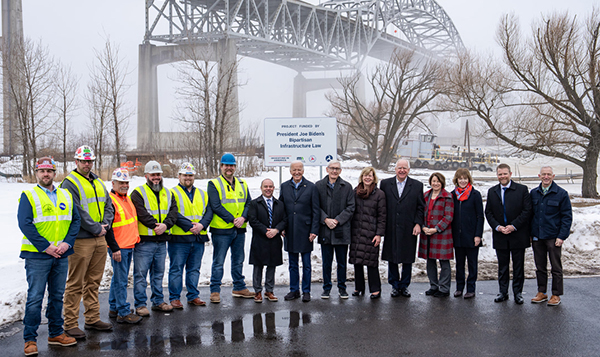
President Joe Biden joined Minnesota Gov. Tim Walz, Wisconsin Gov. Tony Evers and other state and federal leaders Jan. 22 to announce funding for the Blatnik Bridge. Submitted photo |
|
| |
|

|
 |
TABLE of CONTENTS
 |
Name a Snowplow Contest winners offer a flurry of puns and pop culture |
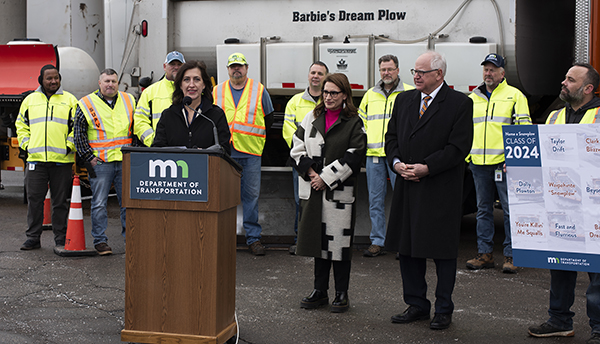
The votes are in and the newest snowplow names are here, with clever nods to movies, music and more.
MnDOT’s fourth annual Name a Snowplow contest drew more than 32,500 votes to select the eight winners, which Commissioner Nancy Daubenberger, Gov. Tim Walz and Lt. Gov Peggy Flanagan announced at an event on Jan. 30. The three also gave details about MnDOT’s hard work, the importance of this work statewide and the hope that this contest helps to improve safety on our roads. Multiple media outlets attended the event, including KARE-TV, WCCO-TV, KSTP-TV, Fox 9, KTTC-TV-Rochester, the Associated Press, the Star Tribune and the Pioneer Press.
Photo by Rich Kemp
Here are this year’s winners and the districts they’ll be serving:
1. Taylor Drift (District 2)
2. Clark W. Blizzwald (District3)
3. Dolly Plowton (District 1)
4. Waipahinte, the Dakota word for “snowplow” (District 8)
5. Beyonsleigh (District 4)
6. You’re Killin’ Me Squalls (District 6)
7. Fast and Flurrious (District 7)
8. Barbie’s Dream Plow (Metro)
|
|
| |
|

|
 |
TABLE of CONTENTS
 |
Traffic Engineering wins Golden Hard Drive |
By Megan Bauer, Office of Chief Counsel
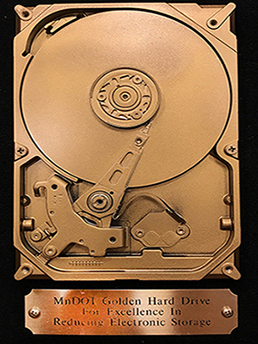
The Golden Hard Drive is awarded to the office or district that reduces the most email storage. Submitted Photo |
Ray Starr and the Office of Traffic Engineering have won MnDOT’s latest electronic file cleanup competition.
Starr and OTE earned the “Golden Hard Drive” award for their hard work creating a network drive organization system with the highest quality, scale, and level of effort among all electronic file cleanup competition submissions. OTE restructured their network drive in late 2022 to improve file access and reduce redundant, obsolete, and trivial (ROT) files.
“I’m truly proud of everyone in OTE that took the time to contribute to our office’s efforts to completely reorganize our electronic filing system,” said Brian Sorenson, OTE Office Director. “Our network folders are now much more intuitive and accessible, and we’re now utilizing eDOCS more effectively to help manage our documents. Special thanks to Ray Starr who led this effort, and congratulations to everyone at OTE in earning this award!”
Competition judges also awarded Starr and OTE the best file organization system entry for eDOCS. Other MnDOT employees submitted the best file organization systems for their respective storage locations:
- OneNote – Jesse Johnson, Metro District
- Outlook – Charlie Melcher, Metro District
- ProjectWise – Charlie Melcher, Metro District
Jesse Johnson talked about the value of OneNote as a tool to organize his information. “OneNote helps me organize information in a way that is easily searchable on my computer, cell phone, and online. I can also share information, such as agendas and meeting notes, with anyone that works at the State…without emailing a single attachment,” said Johnson.
ProjectWise and Outlook winner Charlie Melcher said that implementing an organized filing system with consolidated subfolders helped Metro District employees find documents more quickly. According to Melcher, only saving important documents “eliminates clutter” and helps “reduce frustration and stress.”
“Winning feels good,” said Melcher. “I guess a bit of diligence and time commitment pays off.”
Visit the Electronic File Cleanup SharePoint to see their submissions and get ideas for your own electronic files. On Jan. 29, MnDOT started automatically deleting any messages, attachments, and calendar items stored in Outlook past their delete dates. Consider moving old emails from Outlook to a new or existing electronic file organization system in a designated MnDOT file storage location.
During the next electronic file cleanup competition in May 2024, MnDOT offices and districts will compete to clean up their shared drive files. The MnDOT Information Governance Program will provide more information closer to the competition. |
| |
|

|
 |
TABLE of CONTENTS
 |
Upcoming events highlight OSPH and its role in the agency |
By Julie Bartkey

Beth Kallestad from OSPH recently spoke to Minnesota Public Radio’s “Getting to Green” series about the agency’s initiative to add more than a dozen electric vehicle fast-charging stations along I-94 and I-35. Submitted Photo |
The Office of Sustainability Public Health has an important and growing role in advancing MnDOT’s mission to connect and serve people across the state through a safe, equitable and sustainable transportation system. OSPH serves this mission by working toward the following goals:
- Reducing transportation carbon pollution
- Supporting transportation that improves public health
- Improving resilience of the transportation system
- Developing strategic partnerships to expand innovation
- Leading by example through MnDOT sustainability efforts
From working with MnDOT staff on incorporating Complete Streets into their work to supporting improved walking and bicycling options to help Minnesotans drive less, the OSPH team incorporates carbon reduction measures in much of its work.
Funding came from the Infrastructure Investment and Jobs Act, which was signed into law in 2021. The law authorizes $1.2 trillion for transportation and infrastructure spending with $550 billion of that figure going toward "new" investments and programs.
Minnesota received $240 million of those funds for sustainability programs. They are, and will be, used to help reduce carbon emissions and improve sustainable operations by:
- working with transportation partners to identify and advance statewide strategies for reducing per capita vehicle miles traveled by 20% by 2050,
- coordinating with public and private sector partners to reduce transportation carbon pollution and meet MnDOT’s long-range policy goals,
- implementing Complete Streets Policy
- developing tools to increase use of transit, bicycling, walking and transportation demand management to reduce single occupancy vehicle trips, and to improve the sustainability of winter weather operations through enhanced operator training, equipment calibration and agency-wide accountability
All MnDOT staff are invited and encouraged to participate in a monthly webinar series to learn more about OSPH and its role, share your ideas for coordination and understand how you can incorporate its strategies into your work.
The dates and next topics include:
- Feb. 29, 12 p.m. to 1 p.m. – Complete Streets
- Mar. 27, 12 p.m. to 1 p.m. – Greenhouse and Carbon Reduction at MnDOT
- April 24, 12 p.m. to 1 p.m. – Vehicle Miles Traveled Market Research Findings
- May 22, 12 p.m. to 1 p.m. –Climate Change and Weather and the Resilience Improvement Plan
Preregistration is not required for these events. For more information, including the links to join each event, visit the Sustainability and Public Health page on iHUB. |
| |
|

|
 |
TABLE of CONTENTS
 |
Performance measures dashboard moving to new location |
| By Jake Granholm, Office of Transportation System Management
MnDOT's transportation system performance dashboard is moving. On Monday, Feb. 5, the performance dashboard that has been on the Minnesota GO website will migrate to a MnDOT web address.
MnDOT’s performance dashboard continues to be an important resource to inform and educate local and state decisionmakers on the health of Minnesota’s transportation system. It also increases transparency for the public on the progress MnDOT and its transportation partners are making toward achieving strategic goals.
The dashboard migration is intended to improve accessibility for all users, simplify navigation, increase performance reporting consistency and better accommodate new measures identified in the most recent Statewide Multimodal Transportation Plan. The performance measure visuals and the dashboard organization have been refreshed to create a more concise and clear display that still enables people to engage with the data and dig deeper.
According to the Performance, Risk, and Investment Analysis director, Deanna Belden, the new performance dashboard “continues and improves upon MnDOT’s goal to tell a transparent and clear story about Minnesota’s transportation system, both the achievements and the challenges.”
The OTSM office director, Philip Schaffner, said the updated performance dashboard is “a valuable tool for engaging with people about all the work MnDOT and its partners are doing.” Following the launch, the MnDOT performance dashboard team will continue to improve upon the performance visuals and add performance measures through updated analysis, reporting and outreach.
To view the dashboard once it’s live on Feb. 5, visit the Performance Measures page on MnDOT’s public website. |
| |
|

|
 |
TABLE of CONTENTS
 |
New to the Web: 2022 MnDOT Sustainability Report now available online |
By Doug Mack
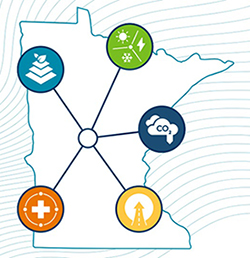
Cover of the 2022 MnDOT Sustainability Report. |
The most recent edition of MnDOT’s annual Sustainability Report is now complete and available online on the agency’s Sustainability and Public Health webpage.
The report includes data from 2022 and provides details on MnDOT’s sustainability goals, progress and strategies for achieving the goals.
Highlights of recent progress include MnDOT meeting its greenhouse gas emissions reduction target for facilities for the fourth year in a row and successfully completing statewide conversion of roadway lighting to LEDs.
|
| |
|

|
 |
TABLE of CONTENTS
 |
On the Job: Fufa Roro helps acquire land needed for projects |
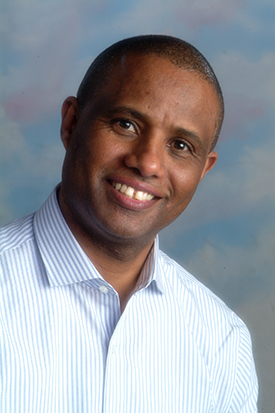
Fufa Roro |
By Doug Mack
Where there is infrastructure, there’s also land and property that must be documented carefully before it changes hands. This documentation is a critical first step in many MnDOT projects, and Fufa Roro works hard to make sure it’s all done right.
How long have you been at MnDOT?
I joined MnDOT in Jan. 2005 and have been with the organization for 19 years.
Tell us about your job and what you do.
The Legal Descriptions and Commissioner's Orders unit is under Surveying and Mapping Section in the Office of Land Management. Our primary responsibility is the preparation of legal descriptions and Commissioner's Orders for the acquisition and disposition (conveyances and turnbacks) of lands under the jurisdiction of MnDOT.
A legal description is a specific and detailed way of identifying a piece of real property; these descriptions are used in legal documents such as deeds, final certificates and other legal instruments to precisely define the boundaries of a property. A Commissioner's Order is a numbered document, either graphic or written, signed by the Commissioner of Transportation or a representative that defines land needed for trunk highway purposes. MnDOT is obligated to have a Commissioner's Order before acquiring any land.
What are your day-to-day tasks? Do they change throughout the year?
Conducting research to gather relevant information. Examining various documents, to verify information and ensure consistency. Working closely with surveyors, legal professionals, and other stakeholders to clarify details and address any discrepancies in property descriptions. Creating precise and accurate legal descriptions and Commissioner’s Orders for lands to be acquired, conveyed or turned back. Maintain records. Certify true copies of Commissioner’s Orders for condemnation.
Regarding changes throughout the year, our tasks may be impacted by various factors, including the volume of parcels acquired by MnDOT for trunk highway purposes. As we supply products for all districts, there are instances when a significant number of jobs originate from different districts simultaneously.
How does your job fit into the broader work of MnDOT?
My work supports the acquisition and disposition of properties crucial for MnDOT's infrastructure projects, including roads, bridges and transportation systems.
What the most challenging and rewarding parts of your job?
Addressing discrepancies in property descriptions can be challenging, especially when collaborating with surveyors and other stakeholders. Resolving such issues requires understanding of the legal and surveying aspects involved. Managing updates and revising legal descriptions in response to changes in property boundaries poses a challenge. Staying alert and adapting to these changes while maintaining accuracy is a continuous process.
The most rewarding parts? Preparing accurate legal descriptions and Commissioner's Orders brings satisfaction, especially knowing that it plays key role in the acquisition of lands for trunk highway purposes. Engaging in problem-solving to resolve complex issues contributes to both professional growth and sense of accomplishment. Maintaining records of legal descriptions and Commissioner's Orders that serve as valuable references in the future is also satisfying.
How has your job changed since your first started?
My job has changed with advancements in technology. Digital tools and software have modernized research processes, making it more efficient to gather information. The use of Geographic Information Systems and other mapping technologies has improved the property boundary assessments.
The flexibility of remote work allows me to perform my job from different locations; this shift has required adjustments in communication methods.
Is there anything about your job that might surprise other people (either inside or outside MnDOT)?
Many people might be surprised by the extent of interdisciplinary collaboration involved in my role. Drafting legal description requires close collaboration with surveyors, Right of Way and GIS specialists and other professionals to ensure accuracy and compliance. The level of coordination across different fields may be unexpected.
Not everyone fully understands the role that legal descriptions play in real estate transactions. The accuracy of these descriptions is very important for the execution of property transactions, and any discrepancies could bring legal consequences.
What are your interests or hobbies outside your work with MnDOT?Outside of my work with MnDOT, I have a diverse range of interests and hobbies, including engaging in outdoor activities such as hiking, cycling, and nature walks. I am always eager to learn new things like acquiring a new language (I currently speak four), exploring a hobby or continuous learning, which is also part of my personal growth.
Do you or a co-worker have an interesting job to share with readers? Send us your ideas, and we’ll contact you for more information.
Recent employee profiles:
|
| |
|

|
 |
TABLE of CONTENTS
 |
AAERG celebrates Black History Month with Lunch & Learns, trivia |
|
By Mary Schaefle, Office of Financial Management
Black History Month 2024 explores today’s inequity for African American communities and how we got to this place. This year’s theme “Where Minnesota Is Today: The Intersection of Place, Policy and Transportation Planning and Investment,” and the events bring renowned Minnesota researchers and leaders to the agency to share their knowledge and expertise.
The African American Employee Resource Group invites all employees to join Lunch & Learns throughout February and to participate in transportation-related Black History Month trivia.
Lunch & Learn with Keith Baker, Executive Director of ReConnect Rondo, Thursday, Feb. 1, from 12 p.m. to 1 p.m.
Reconnecting Rondo aims to connect Minnesota leaders, equity organizations, and the Rondo community to ensure a better, brighter and more equitable future. Their mission is to create a land bridge that reconnects Rondo and reignites a vibrant African American cultural enterprise district in St. Paul. They hope to be a national model for equitable infrastructure and development success while leading a restorative movement in Minnesota. Reconnect Rondo Executive Director Keith Baker will bring MnDOT up to speed on the organization’s current activities, lessons learned from the inaugural Reconnecting Communities Summit in Nov. 2023, and their plans for the future.
Lunch & Learn with Dr. Samuel Leguizamon Grant of Rainbow Research, Monday, Feb. 12, from 12 p.m. to 1 p.m.
Dr. Sam L. Grant’s presentation will focus on how aspects of our built environment and infrastructure were informed by and thus perpetuate the causes and consequences of structural racism, and how examining racism as a strictly social construct has allowed these environmental factors to persist. Dr. Grant’s method of critical participatory action research focuses on the intersectionality of racial, cultural, economic, gender, environmental and geographic justice.
Lunch & Learn with Kirsten Delegard and Michael Corey of Mapping Prejudice, Tuesday, Feb. 27, from 12 p.m. to 1:30 p.m.
MnDOT’s African American Employee Resource Group and the State of Minnesota GIS (GIS Bytes) Collaborative are deeply excited to be hosting a return visit from the Mapping Prejudice Project in honor of Black History Month 2024. Since their first presentation to our community in 2021, Mapping Prejudice has more than doubled their interactive geographic compendium of racially restrictive covenants to include both Ramsey and Dakota counties in addition to the original Hennepin County release. Project Director Kirsten Delegard and Geospatial, Technical, and Data Lead Michael Corey will visit MnDOT to speak on the project’s expanding scope, insights gleaned from more than seven years of exploration and analysis, and their evolving outreach, collaboration, and education efforts.
Closed captioning is available for Lunch & Learn events. These events will be recorded and posted on the ERG events page for later use.
Black History Trivia 2024
By popular demand, the AAERG is hosting an on-going trivia game again this year for the month of February. Sign up below to receive a weekly set of questions:
|
| |
|

|
 |
TABLE of CONTENTS
 |
New blowers deployed in Districts 4 and 8 |
By Emma Olson, District 4 Public Affairs Coordinator
On Jan. 4, staff from District 4 and District 8 were given the first look at two new blowers purchased through the Resource Investment Committee and Operations Division. These new blowers, which cost approximately $1 million for the pair, are designed with 50/50 weight distribution and low center of gravity to allow the tractor to safely travel up to 43 miles per hour from drift-to-drift.
The new tractors come with an increase in horsepower, giving our operators the ability to remove roughly 2,500 tons of snow per hour—that’s about 1,000 tons more per hour than our existing equipment. Other unique features of the new tractors include ABS brakes and hydraulic suspension, as well as customizable operator profiles for each attachment.
The blowers will be housed in District 4 and District 8, but will be available for future statewide use as needed.

Staff from Districts 4 and 8 at the Detroit Lakes Headquarters with the two new tractors. Photo by Emma Olson |
|
| |
|

|
 |
TABLE of CONTENTS
 |
MnDOT convenes with national transportation leaders at TRB Annual Meeting |
By Micaela Kranz, Office of Research & Innovation
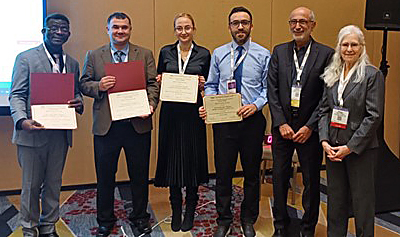
Bernard Izevbekhai (MnDOT), Bora Cetin (Michigan State University), Ceren Aydin (Michigan State University) and Raul Velasquez (MnDOT), pictured left to right, were awarded the 2023 Geology and Geotechnical Engineering Section Best Paper Award for their paper "Improving Field Moisture Monitoring of Recycled and Virgin Aggregates.” Photo provided by Bernard Izevbekhai |
MnDOT staff joined thousands of transportation administrators, practitioners, policy makers and researchers at the 103rd Transportation Research Board Annual Meeting, which was held Jan. 7-11 in Washington, D.C. MnDOT staff presented their work in more than 35 workshops, presentations, and poster sessions, with topics including “Designing the Transportation Agency of the Future,” “Expanding Connectivity and Electrification for Electric Vehicle Charging Infrastructure” and “Assessing the Sustainability of Asphalt Pavements.”
A number of staff received awards for their work, including:
- Geology and Geotechnical Engineering Section Best Paper Award for “Improving Field Moisture Monitoring of Recycled and Virgin Aggregates”: Bernard Izevbekhai and Raul Velasquez, MnDOT Materials & Road Research
- 3rd Place in the Standing Committee on Research & Innovation Implementation Poster Session: Hafiz Munir, MnDOT Research & Innovation
Videos from the event are available online, including the the Chair's Plenary Session on mental wellness in the construction and transportation industries, and the Thomas B. Deen Distinguished Lecture, given by Susan Handy, Distinguished Professor of Environmental Science and Policy and Director of the National Center for Sustainable Transportation at University of California, Davis.
|
| |
|

|
|
|
|



